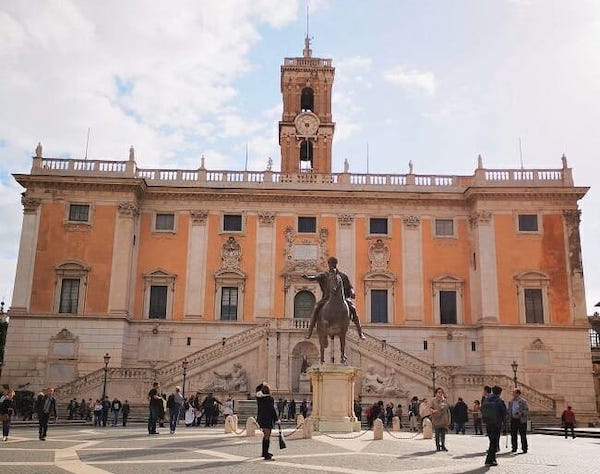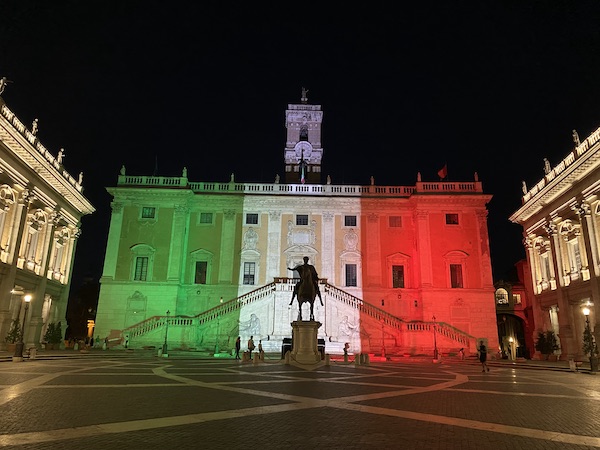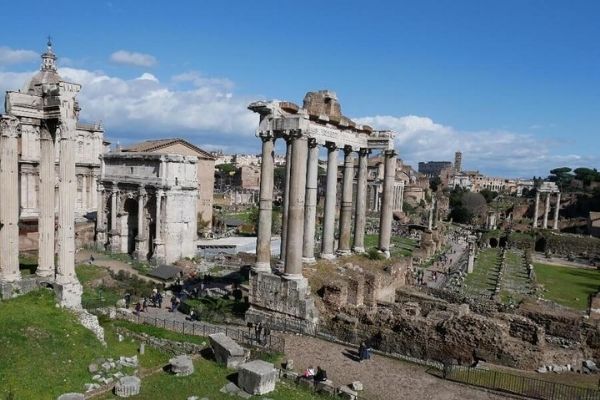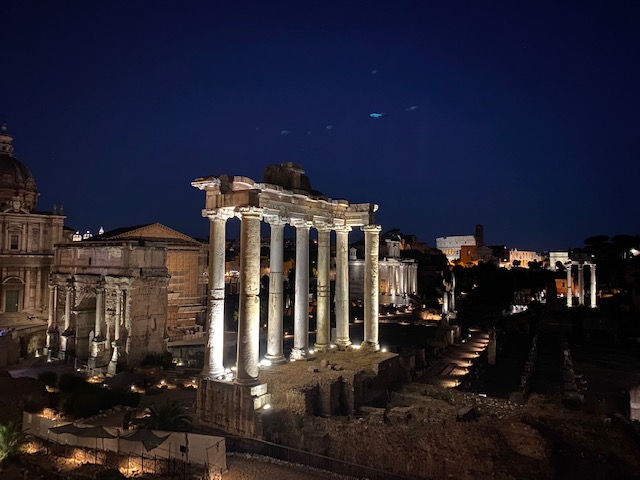All you need to know about the Capitoline Hill (Colle Campidoglio) in Rome: what makes the Capitoline hill special, how to visit, interesting facts.
The Capitoline Hill, the Campidoglio hill or even just ‘Il Campidoglio’, in Italian, is one of the seven hills of Rome and one of the most beautiful to visit.
Located in the center of Rome, the Capitoline Hill is one of the most historically significant of the Rome hills and it nowadays famous both for the role it had in ancient Roman times and for an important intervention by Michelangelo, who turned the hill into one of the most beautiful piazzas in Italy.

In this guide, I am going to give a quick overview of the Capitoline Hill history, the best things to see there and how to visit.
I am sure by the end of it you will agree, the Capitoline hill deserves to be in your Rome itinerary.
Need to know: In English, the hill is often referred to as ‘Capitoline Hill’ or, sometimes, ‘Capitol Hill of Rome’ or ‘Rome Capitol’. In Italian, the hill is called Campidoglio, pronounced Camp – ee- do – gli – o, where gli is the phonetic sound ⟨ʎ⟩ pronounced a little like a Spanish ll or like a stong yi – not as in the English gliss. I imagine the difficult pronunciation is a big reason why, unlike other locations, this hill is mostly known to non-Italian speakers by its English name!
Why is the Capitoline Hill important
The Capitoline hill is important on several accounts.
In ancient Roman times, the Capitoline hill was an important religious location.
The hill used to have two summits, the Arx and the Capitolium, separated by a flatter area, the Asylum, where Piazza del Campidoglio is now.
This Asylum area is mentioned in connection to Romulus, the founder of Rome, who is said to have used to house people coming from outside Rome and is also the area that hosted important temples such as that to Giove Ottimo Massimo (aka Giove Capitolino), devoted to Jupiter, Juno and Minerva and that to Juno Moneta.
The Capitoline hill was also the place with the Tabularium (City archive) and, lastly, the hill with the infamous Tarpeia Rock, the cliff at the southern edge of the hill, where executions of traitors took place.
The hill is also famous for an important design intervention by Michelangelo.
In 1538, under the Papal order of upgrading the appearance of the area, he tranformed this ancient hill into an elegant square that is, nowadays, one of the most beautiful piazzas in Rome and one of the most visited Rome landmarks.
Nowadays, the Capitoline Hill is a historical landmark, a beautiful piazza, and also the seat of Rome City Council (Comune di Roma).
How to visit the Capitoline Hill
Access to the Capitoline Hill is free and open 24h/7.
The main, monumental access to the square is from the staircase designed by Michelangelo, climbing up the hill from Piazza dell’Ara Caeli, beside Piazza Venezia.
Other accesses also exist, one from the back of Giano’s Arch and the other from beside the Vittoriano.
The iconic view of Piazza del Campidoglio is from Michelangelo’s staircase so, for your first visit, I highly recommend you start your visit from there.
Piazza del Campidoglio is outdoors so no special dress code is necessary.
While the staircase is not steep not hard to climb, good shoes are recommended: you can find my list of recommended shoes for Rome sightseeing here.
The Capitoline Hill and Piazza del Campidoglio can only be visited on foot so no matter how you get there, some walking is required.
You can visit the Capitoline Hill day and night and I recommend you do both: during the day, you can access the museums while at night, you can enjoy stunning views of the Piazza and the Roman Forum below.
The Capitoline Hill offers one of the best views over Rome, it is one of the most charming places to see in Rome at night and one of the best things to visit in Rome for free.
The Capitoline Hill: where it is and how to get there
The Capitoline Hill is located in Rome city center, beside Piazza Venezia and the Roman Forum.
Buses serving Campidoglio are: 40, 60, 64, 80, all the buses serving Piazza Venezia, Colosseum Metro B stop (Piazza Venezia metro stop under construction). Good to know: this is one of the Rome attractions that can be easily visited with a hop-on, hop-off bus tour, since the shop is in Piazza Venezia, only a couple of minutes from the Hill.
Attractions close to the Capitoline Hill and that can be visited on the same day are:
- The Vittoriano – one minute walk from the Piazza, the building leans onto the slopes of the Capitoline Hill
- The Roman Forum – just below the hill. Access is about 5 minutes walk from the Piazza
- Trajan’s Column – 2 minutes walk
- The Colosseum – 10 minutes walk
- The Circus Maximus – 10 minutes walk
- Monti Neighborhood – 5 minutes walk
- Rome Ghetto – 5 minutes walk
- Basilica di Santa Maria in Ara Caeli – just beside the main Piazza entrance
What to see on the Capitoline Hill Rome
The Capitoline Hill as we see it today is crowned by an elegant piazza called Piazza del Campidoglio, designed by Michelangelo and completed by Michelangelo himself and architect Giacomo dalla Porta during the course of the XVI century.
The best things to see there are:
Piazza del Campidoglio
Piazza del Campidoglio is the stunning, monumental Piazza at the top of the Capitoline Hill. Designed by Michelangelo, it is one of the most beautiful Piazzas in Rome and is composed by several elements worth seeing. The most impressive are:
Cordonata – the main staircase to Piazza del Campidoglio
Access to Piazza del Campidoglio, the summit of the Capitoline Hill, is via a monumental staircase designed by Michelangelo, the so called ‘Cordonata’.
The Cordonata climbs gently up the slopes of the hill and has two statues at its top, working as a grand entrance to the piazza itself.
The two statues represent the Dioscuri, Castor and Pollux, represented as strong young men standing beside mighty horses.
If you love Michelangelo’s work, see also: where to see masterpieces by Michelangelo in Rome
The equestrian statue of Marcus Aurelius
As you step into Piazza del Campidoglio, your eyes are drawn to its focal point, a large bronze equestrian statue of Emperor Marcus Aurelius, one of the most important statues in Rome.

The statue is a replica (the original is in the Capitoline Museums, on the same square) however, it has huge importance in the history of Roman Archaeology and art.
This is the only bronze equestrian statue that got to us from Roman times and it is therefore unique and invaluable.
It is said that the statue was mistaken for one of Emperor Constantine, which would explain why it got such a dominant place in Papal Rome. However, there is now agreement among art historians that it represents Marcus Aurelius and most likely dates back to 176 – 180 AD.
The geometric pavement of the Piazza
The statue of Marcus Aurelius stands at the center of a beautiful, geometrical design also imagined by Michelangelo.
The design is made of several curves ovals that create almost a flower design and draw the eye to the center of the square.
Symbolically, this wanted to make Piazza del Campidoglio the umbilicus urbis, the city navel.
Fun facts: the pavement of this piazza and Marcus Aurelius are so significant, they are on the Italian 50 cent Euro coins and on the inside of Italian passports!
Palazzo Senatorio and the fountain to the Rome Goddess (Fontana della Dea Roma)
The back of piazza del Campidoglio is occupied by stunning Palazzo Senatorio and a large, interesting Rome fountain, fontana della Dea Roma.
Palazzo Senatorio was built in the Middle Ages on the ruins of the Tabularium, the city archive, and was redesigend by Michelangelo as part of its ugrade of the area.
During his intervention, he created the staircase we see now and also used two already existing statues representing the Nile and the Tigris rivers as decorations.
Later in the same century, the statues were modified to represent the Nile and the Tiber and used to create a new fountain, La Fontana della Dea Roma, with the two rivers the sides of a sitting statue of Minerva.
Fun fact: there is another Fontana della Dea Roma in the city, and it is located in Piazza del Popolo!
Palazzo dei Conservatori, Palazzo Nuovo and the Capitoline Museums
Piazza del Campodiglio has two more beautigul palazzi: Palazzo dei Conservatori and Palazzo Nuovo.
Palazzo dei Conservatori dates back to the XIII century: at the time, it was called ‘Palazzo delle Corporazioni’ and was used as the seat of the city offices.
Palazzo Nuovo faces it and together they are the beautiful home to the Capitoline Museums: these are among the most beautiful and interesting museums in the city, home of many of the most significant Roman sculptures in the world, including the famous she-wolf of Rome, the Capitoline Wolf.
The Replica of the Rome she-wolf
On the left of Palazzo Senatorio, it is worth noticing a column with a statue of a she wolf nursing two twin boys. This statues is a replica of the original Capitoline Hill sculpture hosted in the museum and can be fun to spot if you cannot see the real thing for lack of time or ticket availability.
The view over the Roman Forum
The Capitoline Hill uses to be Rome’s Citadel and overlook the forum, something that is it still true today.
When Michelangelo designed Piazza del Campidoglio, he wanted it to face the Vatican and effectively turned around what would have been the square’s original orientation.
However, if you go to the back of the renaissance piazza, you can still appreciate its position: from the back of Piazza del Campidoglio, you have one of the most beautiful views of ancient Rome you can ever ask for!
As mentioned above, I recommend you come here twice to admire the Forum from the Capitoline Hill during the day

And also at night. This is one of the most scenic spots in Rome, and one of the most romantic: if you are looking for a place to propose in Rome this would be a good one!

Where to stay near the Capitoline Hill Rome
The Caoitoline Hill is in Rome city center and you will be close it choosing a hotel close to the Pantheon or even a hotel close to the Colosseum.
The closest hotel of all is Hotel Otivm, which happens to be one of my favorite hotels in Rome, thanks to lovely rooms and a wonderful rooftop terrace.
This is one of the best areas to stay in Rome.
I hope you enjoyed this overview of what to see on the Capitoline Hill in Rome and has answered your questions about it. Safe travel planning!
Capitoline Hills Frequently Asked Questions
The Capitoline Hill is located in Rome city center, close to Piazza Venezia, the Roman Forum and not far from the River Tiber.
Access to the Capitoline Hill and Piazza del Campidoglio is free. If you wish to visit the Capitoline Museums there, however, you will need tickets that can be purchased on the day or, in advance, from the museum website. Access to the museum is not necessary to visit the area.
in Roman times, the Capitoline Hill was the city’s citadel and an important religious center with temples to the main Rome deities. From the Middle Ages, it has been the seat of the Rome city administration and in Renaissance times was transformed into an elegant city space now hosting the Rome City Council and the Capitoline Museums.
